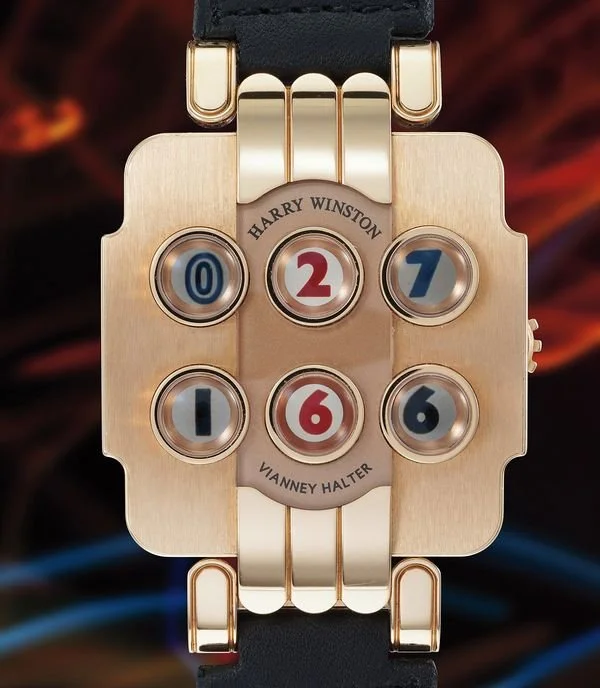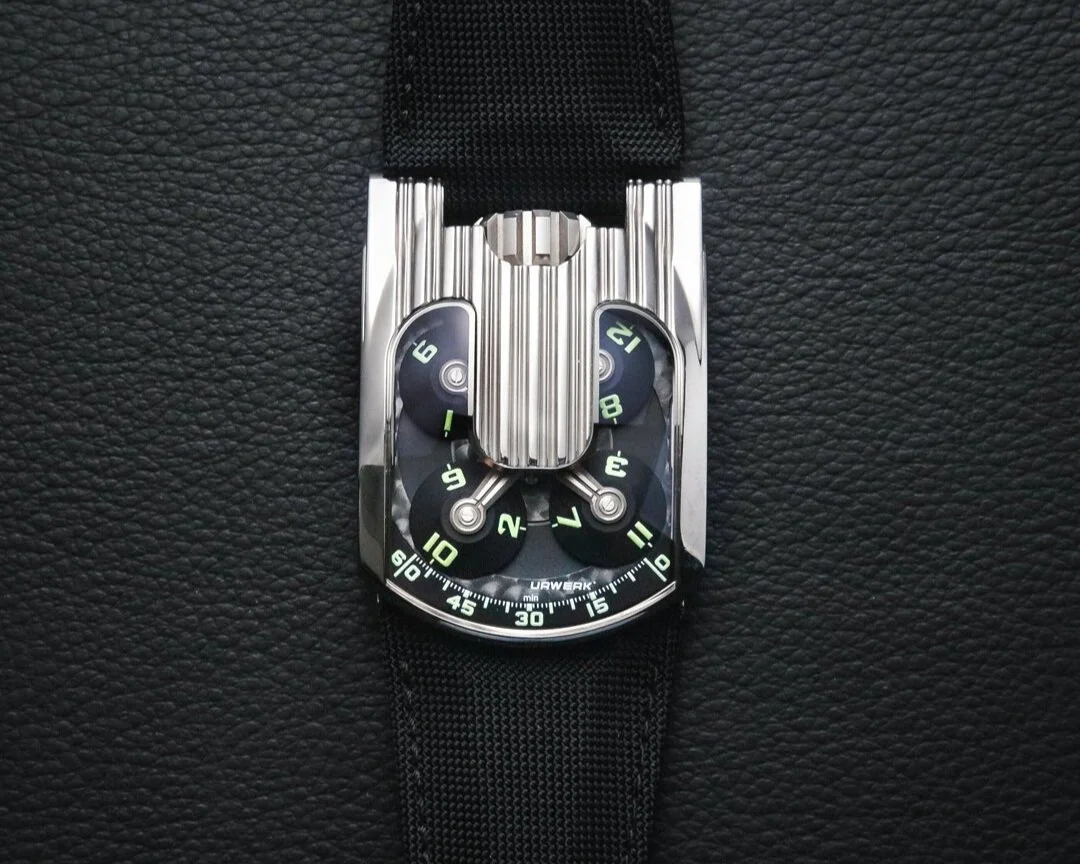The Beginnings of Avant-Garde Watchmaking – A Chat With Jean-François Mojon
How something begins is always such a curious event. Why not earlier? Or later? What factors came together for something to begin in the first place? These are questions to ask when thinking about the beginnings of modern independent watchmaking. Especially timepieces with avant-garde design, many of these “new age” creations came about in a burst between the late 1990s and mid 2000s. Within the span of roughly seven years, the watch community witnessed the arrival of Vianney Halter’s Antiqua, Urwerk’s UR-101, Richard Mille’s RM001, Ulysse Nardin’s Freak, the launch of the Opus Collection orchestrated by Max Büsser during his time at Harry Winston, and then MB&F’s Horological Machine 1. The floodgates opened.
One of the earliest examples of avant-garde watchmaking, Vianney Halter’s Antiqua
The literary critic, Edward Said speaks of “beginnings” at length in one of his books – “[they’re] not only a kind of action[, but] also a frame of mind, a kind of work, an attitude, a consciousness.” Today, we’re examining the mood that captured a group of watchmakers and brands in the late 1990s. Doing so, we hope to lay out some of the conditions that inspired and propelled the beginning of avant-garde watchmaking.
To provide some needed context, we spoke with Jean-François Mojon, master watchmaker and complication developer at Chronode SA. From his position as R&D Manager at IWC from 2000-2005 and founder of Chronode from 2005, Mojon watched the industry evolve throughout this period. The master watchmaker’s work with Chronode includes contributions to MB&F’s Legacy Machine, the Cyrus Vertical Tourbillon, as well as Hermès' Arceau Le Temps Voyageur.
Master watchmaker Jean-François Mojon at his workbench
The landscape – the technology and the market in the 1990s
“When I started watchmaking school in 1982, there were only two other students in my class at watchmaking school in La Chaux-de-Fonds. People asked, ‘What are you doing? Watchmaking is dead!’” Such a casual and comical comment by Mojon, it’s easy to forget how genuinely uncanny the 1980s through mid 1990s was in the watchmaking industry.
There was very little high-end watchmaking. Audemars Piguet had only manufactured the first tourbillon in an automatic watch in 1986 (when Mojon finished his studies). Blancpain and IWC launched a “complications arms race” with the 1735 Grande Complication and Il Destriero Scafusia, respectively releasing each some 5+ years later in 1991 and 1993. A. Lange & Söhne had not yet restarted as a brand. The Royal Oak Offshore “The Beast” released a 100-piece run to test the waters in the market for a sportier, larger version of the brand’s bestseller. This was an early experiment (or vision) for the overall trajectory of the market for decades to come.
“Movement of Blancpain’s 1735 Grande Complication, one of the seeds of the modern luxury watchmaking industry”
All of this effort, all of the new, finely finished, complicated releases bore fruit. By the mid 1990s, the watch industry had slowly established a foundation similar to what we know today – a strong focus on fine craftsmanship and finishing, a wide variety of complications, and wider range of aesthetics.
Before we dive into the aesthetic shift to the avant-garde, there are a few things working together to allow for this huge wave of complicated and ultra-complicated timepieces. Mojon mentions, “the arrival of CAD and CNC machinery made the design and development of all types of new complications much easier, much faster.” Computers became much less expensive during this time period from the mid 1990s to the mid 2000s. We see more and more engineers, across all disciplines, working with software applications for design, feasibility testing, simulation, etc. This enabled watchmakers to conceptualize, design, and manufacture components and mechanisms with increasing complexity. The ability to manage heightened complexity mapped directly onto the complexity of timepieces. Working behind the scenes, technology played a significant role in the rebirth of the watch industry in the fallout of the Quartz Crisis.
As technology assisted in the development of complicated, modern timepieces, the market was warming up to their arrival. Throughout the 1990s, there was relatively minimal growth – Swiss watch exports were ~4b CHF in 1990 and ended the decade at ~5b CHF. That foundation became the launch pad for massive growth through the turn of the century though, with the export market tripling in size between 2000 and 2008. These market conditions welcomed the arrival of more and more avant-garde timepieces. Vianney Halter, Urwerk, Ulysse Nardin, Richard Mille, Harry Winston, they all were able to sell enough to reinvest in the development of the next watch. Survival, at the beginning, proved enough.
The courage to be unusual, incentivized
The watch industry is generally very conservative. Development cycles are long. Many brands err on the side of caution – who wants to spend five years developing a “radical” timepiece without guarantee of success? As many already know, “radical” is rarely the goal.
“Journe’s work for the Harry Winston Opus 1, one of the defining collections of early indie watchmaking”
The market began to reward the wild and crazy though, at least enough for craftspeople to survive. As Mojon points out, “You can almost see how avant-garde watchmaking developed, only by looking at the Opus Collection. It starts more conservative, but with Opus 3 (crafted by Vianney Halter in 2003), Opus 5 (crafted by Urwerk in 2005), Opus 6 (crafted by Greubel Forsey in 2006), it feels like the doors are wide open for crazy ideas.”
The avant-garde aesthetic jump with Halter’s Opus 3 was a major “moment” for radical watchmaking
The Opus 1 in collaboration with F.P. Journe and Opus 2 in collaboration with Antoine Preziuso feature timepieces with a more classical aesthetic. Halter’s Opus 3 features a highly unusual, six porthole indication of time on a hefty squared case. With its highly complex movement with ten discs, it’s amazing that Halter’s Opus 3 indicates only hours, minutes, seconds, and a date. It made a huge splash, and propelled avant-garde watchmaking into the limelight within the broader watch and jewelry world.
Here, we begin to observe part of the self-fulfilling prophecy of avant-garde watchmaking’s popularity: in an industry with broadly conservative shapes and mechanisms, exciting and future-forward designs attract a lot of attention. This baseline differentiation is a major part of what helped this new generation of modern watchmakers establish their footing in the industry.
From zero to 60 in no time
We’ve spoken to Mojon previously about the development of complications. He views the golden age for complication development to be from the early 2000s until the 2008 financial crisis. To fully understand how avant-garde watchmaking arrived, beyond the technological and economic conditions, we also need to see how quickly the pendulum swung.
“By the mid 2000s, brands were not worrying at all about commercialization or how an ultra-complicated watch aligns with the brand. It was a very free period for creativity,” mentioned Mojon. “This doesn’t necessarily mean it is a good thing though,” emphasized Mojon. There are a lot of timepieces from that period that feel almost random – the story being, “we could, so we did.” This period played a significant role in establishing avant-garde watchmaking as a bonafide fixture in the modern tradition. In a ten-year period, the pursuit of futuristic designs and ultra-modern complications went from nearly non-existent to fairly abundant.
“Urwerk’s UR-103, released in the mid 2000s, is an example of early avant-garde watchmaking.”
Even when the global economic conditions shifted due to the 2008 financial crisis, there remained wind in the sails of modern watchmaking. This is something akin to the internet bubble of the late 1990’s. The sheer volume of wild and crazy ideas, without any commercial feasibility, disappears, but the underlying trends persist. The internet bubble collapsed due to hyper-inflated valuations on e-commerce business, but in the years that followed, e-commerce exploded. Silicon Valley entrepreneur and investor, Peter Thiel would say, the bubble burst but directionally, the market was right. The same applies to avant-garde watchmaking post-2008. Maybe the current watch market is less courageous (or unhinged?) compared to the mid 2000s. But there is no shortage of avant-garde complications, designs, and timepieces. Even throughout the market ups and downs of the past five years alone, there’s more and more hunger for innovation and novel designs than ever before.






